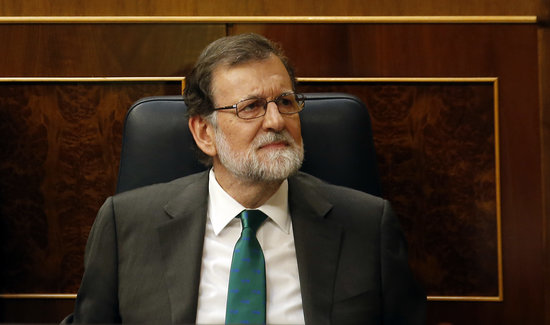Rajoy stripped of Spanish presidency
Pedro Sánchez to form new Socialist government in coming days with votes of Catalan pro-independence parties

The Spanish government that removed the Catalan executive last October is now getting a taste of its own medicine. Mariano Rajoy was stripped of the Spanish presidency on Friday morning after a motion of no-confidence against him was successful. The voting in the Spanish Congress gathered 180 votes in favor, 169 votes against and 1 abstention. It only became clear the motion would pass on Thursday, after the Catalan pro-independence parties, PDeCAT and ERC, and the Basque Nationalist Party agreed to support it. Mariano Rajoy’s cabinet is now history, and in the coming days will be replaced by a Socialist executive led by party leader Pedro Sánchez.
Why did Rajoy fall?
The end of Rajoy’s rule in Spain comes a week after his People’s Party (PP) was convicted in the so-called Gürtel case, a major corruption scandal involving kickbacks-for-contracts.
Pro-independence forces ERC and PDeCAT, as well as the Basque Nationalist Party (EAJ-PNV) and EH Bildu, confirmed their support for the motion on Thursday, adding their votes to those of left-wing Unidos Podemos and its regional allies, as well as the Socialists (PSOE) themselves, who put the motion forward.
Rajoy's main ally, Ciutadans, urged the president to stop the no-confidence vote by resigning and calling a snap election—a request that fell on deaf ears, as a senior PP official confirmed later in the day that Rajoy had no plans to step down. At the eleventh hour, the PP spokesman Rafael Hernando asked the Socialist leader to withdraw his initiative.
What was Rajoy’s approach to the debate?
Mariano Rajoy did not turn up for the afternoon session of the debate on Thursday. Instead, he spent eight hours in a Madrid restaurant with some ministers. On Friday morning, he only appeared in the chamber an hour and a half after the session had started. Before the vote took place, Rajoy conceded defeat in a short speech in Congress. “It’s been an honor serving as Spain’s president and leaving a better Spain than the one I found,” he said. The previous morning he attended the chamber to confront Sánchez and to defend his position as president. In his speech he referred to Catalonia to attack the Socialist leader.
What did the Socialist president-to-be say about Catalonia?
Last October, the PSOE Socialist party backed Rajoy when he imposed direct rule on Catalonia following a declaration of independence. In recent weeks, Sánchez has ramped up his criticism against the pro-independence movement. He also took Catalonia's new president, Quim Torra, to task for a series of controversial tweets in which he criticized Spaniards, calling him a "racist" and "supremacist."
In an attempt to relieve tensions, during the no-confidence debate Sánchez promised to "rebuild bridges" and "set the foundation to normalize the relationship and initiate dialogue between the Spanish and Catalan governments."
How did the Catalan parties vote?
Out of the 47 Catalan MPs in the Spanish Congress, 36 voted for the motion. That number includes the 7 unionist Socialist MPs, the 12 members of En Comú Podem –the Catalan ally of Spain’s Podemos party, which is non-aligned in the independence debate–, and 17 pro-independence MPs, including 9 members of ERC and 8 PDeCAT members. The 6 MPs of, until now, Spain’s ruling People’s Party and the 5 representatives of the unionist Ciutadans party voted against. Overall, 180 out of the 350 MPs supported the motion and ousted Mariano Rajoy from power.
What now?
The Spanish Congress bureau president will inform King Felipe VI, who will appoint Pedro Sánchez as the new President of Spain. Sánchez will then form a new government. It is not yet known whether the new cabinet will also include Podemos. Some minister from Catalonia is expected to be appointed, with Catalan Socialist leader Miquel Iceta and MP Meritxell Batet among the favorites to get a post. Meanwhile, a Catalan government is also about to be formed and direct rule lifted.